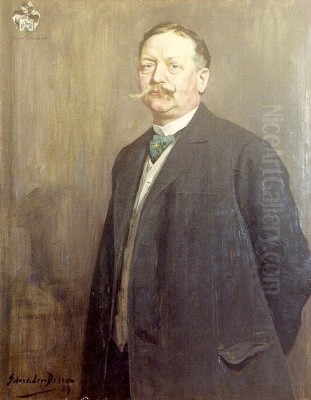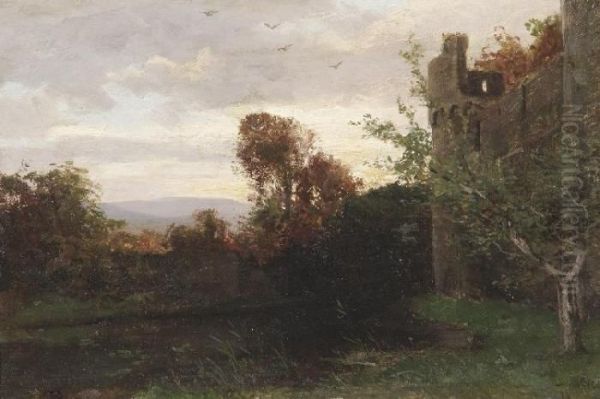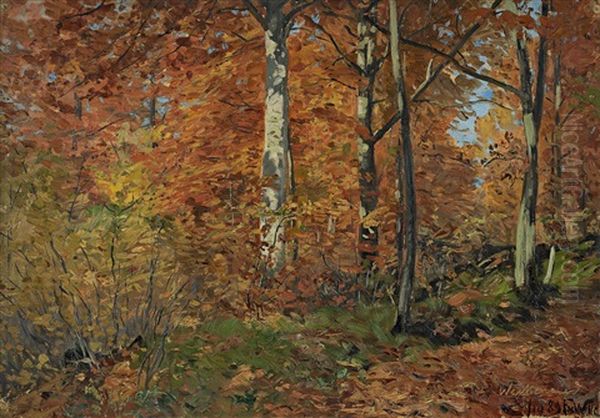Introduction to the Artist

Fritz von Wille (1860-1941) stands as a significant figure in German landscape painting, celebrated particularly for his evocative depictions of the Eifel region. Born in Weimar and passing away in Düsseldorf, von Wille dedicated much of his artistic career to capturing the unique natural beauty and atmosphere of the Eifel mountains, securing his legacy as the preeminent painter of this distinctive German landscape. His work, primarily rooted in the traditions of Romanticism and Late Romanticism, also shows influences from Realism and Impressionism, resulting in a unique and highly personal style.
Von Wille's connection to the Eifel was profound. He wasn't merely an observer but an artist deeply attuned to the region's specific geological features, its changing seasons, and its subtle moods. His paintings often feature the volcanic maars, rolling hills, ancient castles, and flowering meadows characteristic of the area, rendered with a sensitivity that transcends mere topographical accuracy. He became synonymous with the Eifel, his art shaping the visual identity of the region for many.
Early Life and Artistic Formation
Born Friedrich Wilhelm von Wille on October 20, 1860, in Weimar, Fritz von Wille entered a world already steeped in art. His father was the landscape painter August von Wille (1828-1887), and his mother, Clara von Wille (née von Böttcher, 1837-1883), was an accomplished animal painter. This artistic household undoubtedly provided an early and immersive exposure to the world of painting and the traditions prevalent in Germany at the time, particularly those associated with the Düsseldorf School of painting, with which his father had connections.
While specific details of his formal training are not extensively detailed in every source, his upbringing and later career strongly suggest an education aligned with the academic standards of the period. His family moved to Düsseldorf in 1863, placing him firmly within the orbit of the influential Düsseldorf Academy. It is highly probable that he received instruction there or was significantly influenced by its teachings, which emphasized detailed observation, technical proficiency, and often, a Romantic sensibility towards landscape.

A significant journey undertaken between 1888 and 1889 took von Wille to Italy. Such trips were common for Northern European artists seeking inspiration from classical landscapes and the southern light. While his primary focus remained the German landscape, particularly the Eifel, this Italian sojourn likely broadened his artistic horizons and may have subtly influenced his handling of light and composition, adding another layer to his developing style.
The Call of the Eifel
The Eifel region, a low volcanic mountain range in western Germany, became Fritz von Wille's enduring muse. Its unique landscape, characterized by volcanic cones, crater lakes known as maars, deep valleys, expansive plateaus, and ancient castles perched on hilltops, offered a wealth of subjects that resonated deeply with his artistic temperament. He began exploring the Eifel intensely from the 1880s onwards, drawn to its rugged beauty and atmospheric qualities.
Von Wille developed an intimate knowledge of the Eifel, returning repeatedly to specific locations that held particular significance for him. The Weinfelder Maar (also known as the Totenmaar), one of the most famous Eifel maars near Daun, became a signature motif in his work. He painted it numerous times, capturing its serene yet melancholic beauty in different seasons and under varying light conditions. Other locations like Gerolstein, with its distinctive dolomite rocks, and the numerous castles dotting the landscape, such as Burg Reifferscheid, also featured prominently.
His dedication to the Eifel went beyond simply painting its scenery. He purchased Kerpen Castle near Daun in 1911, making the Eifel his permanent home and further solidifying his connection to the region. This deep immersion allowed him to capture the spirit of the place, not just its physical appearance. His paintings convey a sense of belonging and a profound understanding of the Eifel's unique character, contributing significantly to its popular image as a region of romantic natural beauty.
Artistic Style and Development
Fritz von Wille's artistic style is often categorized within the German landscape tradition, evolving from the Düsseldorf School but developing into a distinctive personal expression. His work is fundamentally Romantic, emphasizing emotion, atmosphere, and the sublime beauty of nature. He possessed a remarkable ability to convey a "romantic and soft" atmosphere, imbuing his landscapes with a poetic quality.

While rooted in Romanticism, von Wille's style was not static. It incorporated elements of Realism in its careful observation of natural detail and geological formations. Furthermore, particularly in his later works, one can discern the influence of Impressionism. This is evident in his heightened attention to the effects of light and atmosphere, his often brighter palette compared to earlier Romantics, and a looser, more suggestive brushwork in certain passages, especially when depicting foliage or flowering fields.
His use of color was distinctive. While some sources mention the use of dark and brown tones to create depth and mood, particularly in autumnal or forest scenes, he was also capable of employing vibrant colors, especially when depicting the Eifel in spring or summer, such as the brilliant yellows of flowering gorse or the blues mentioned in the title Die Blaue Blume. He masterfully captured the interplay of light and shadow, defining the contours of the land and creating dramatic or serene effects depending on the subject.
Some descriptions note an "abstract and stylized" quality in his landscapes. This likely refers to his compositional choices and his willingness to simplify forms or emphasize certain elements for expressive effect, moving beyond strict photographic representation towards a more personal interpretation of the landscape. His compositions often feature wide, panoramic views or focus on specific, evocative details, sometimes conveying a sense of solitude or the quiet grandeur of nature.
Key Works and Analysis
Fritz von Wille's extensive oeuvre includes numerous paintings that have become iconic representations of the Eifel. Among his most important and representative works are:
Am Weinfelder Maar (At the Weinfelder Maar): This subject, painted multiple times, is perhaps his most famous. These works typically depict the deep blue crater lake surrounded by the gentle slopes of the volcanic cone. Von Wille masterfully captures the unique atmosphere of the maar – its stillness, its depth, and the often dramatic sky above. The paintings convey both the geological uniqueness and the romantic melancholy associated with this Eifel landmark. His handling of light on the water and the surrounding landscape is particularly noteworthy.
Die Blaue Blume (The Blue Flower): The title itself evokes German Romantic symbolism, where the Blue Flower represented desire, love, and the metaphysical striving for the infinite and unreachable. While the specific flower depicted might be viper's bugloss or similar Eifel flora, the painting likely transcends mere botanical study. It emphasizes the vibrant color and the effect of sunlight on the blossoms, showcasing von Wille's ability to combine detailed observation with a poetic, possibly symbolic, sensibility, characteristic of Late Romanticism.
Burg Reifferscheid in der Eifel (Reifferscheid Castle in the Eifel): This work exemplifies von Wille's interest in integrating historical architecture into the natural landscape. Castles were potent symbols for the Romantics, evoking history, chivalry, and the passage of time. Von Wille depicts the castle nestled within or dominating the surrounding Eifel hills, often using light and atmosphere to create a sense of drama or picturesque charm, highlighting the harmonious or sometimes contrasting relationship between human structures and nature.
Eifel Landscape with Flowering Gorse: Many of von Wille's paintings celebrate the Eifel in bloom. Works depicting flowering gorse are notable for their vibrant yellow hues, often set against the blues and greens of the landscape and sky. These paintings showcase the influence of Impressionism in their bright palette and focus on capturing the fleeting effects of light on the blossoms, conveying the energy and beauty of the Eifel spring.
Other significant works mentioned include Der Frühling am Marksburg (Spring at Marksburg, 1897), capturing a specific seasonal moment at another castle location (though Marksburg is on the Rhine, suggesting his scope sometimes extended beyond the Eifel proper), Gerolstein, focusing on the distinctive rock formations of that area, Mohrblüte bei Hillesheim (Poppy Bloom near Hillesheim), highlighting specific flora, and Herbstwald im Harz (Autumn Forest in the Harz), indicating he also painted other German regions. His work Heidenschanze likely depicts a specific Eifel location known for its natural or historical significance.
Context: The Düsseldorf School and Contemporaries
Fritz von Wille's career unfolded during a dynamic period in German art. He was intrinsically linked to the legacy of the Düsseldorf School of painting, one of the most influential art academies in 19th-century Germany. Known for its emphasis on detailed realism, narrative subjects, and particularly, landscape painting, the school produced artists who gained international recognition. Masters like Andreas Achenbach (1815-1910) and his brother Oswald Achenbach (1827-1905) were leading figures in landscape painting associated with Düsseldorf, known for their dramatic and meticulously rendered scenes. Fritz von Wille's own father, August von Wille, was part of this tradition. Fritz inherited this focus on technical skill and landscape but adapted it to his own Late Romantic and subtly Impressionistic vision.
While rooted in the Düsseldorf tradition, von Wille worked concurrently with major shifts in German art. The profound legacy of German Romanticism, epitomized by the earlier Caspar David Friedrich (1774-1840), provided a foundational context for landscape painting imbued with emotion and symbolism. Although von Wille's style was less overtly symbolic than Friedrich's, the Romantic emphasis on nature's power and beauty is evident.
He also witnessed the rise of Realism in Germany, championed by artists like Wilhelm Leibl (1844-1900) and Hans Thoma (1839-1924), who focused on unidealized depictions of everyday life and nature. While von Wille maintained a more romanticized view, the realistic attention to detail in his work shows an awareness of these trends.
Furthermore, German Impressionism emerged during his active years, with leading figures like Max Liebermann (1847-1935), Lovis Corinth (1858-1925), and Max Slevogt (1868-1932). These artists embraced brighter palettes, looser brushwork, and a focus on capturing fleeting moments of light and atmosphere, often depicting urban scenes or plein-air landscapes. Von Wille selectively incorporated some of these techniques, particularly the brighter colors and attention to light effects, without fully abandoning his Romantic foundations. Artists like Lesser Ury (1861-1931) also explored light and atmosphere in urban and landscape scenes. The Symbolist movement, with figures like Arnold Böcklin (1827-1901) known for his atmospheric and mythological landscapes, also formed part of the complex artistic milieu of the late 19th and early 20th centuries in German-speaking lands. Von Wille navigated these diverse currents, forging his own path centered on the Eifel landscape.
Available sources do not indicate specific collaborations or documented rivalries between Fritz von Wille and these or other contemporaries. His focus appears to have been intensely personal, centered on his relationship with the Eifel landscape. He operated within the broader context of these movements, absorbing influences while maintaining his unique artistic identity.
Legacy and Recognition
Fritz von Wille achieved considerable success and recognition during his lifetime and remains a highly regarded figure in German art history, particularly as the definitive painter of the Eifel. His works were widely exhibited and collected, and Kaiser Wilhelm II acquired several of his paintings, including Die Blaue Blume, indicating significant contemporary acclaim. His deep connection to the Eifel earned him the affectionate title "Maler der Eifel" (Painter of the Eifel).
His reputation has endured. Von Wille's paintings continue to be sought after by collectors and appear regularly at auction houses, often commanding significant prices. Works like Am Weinfelder Maar or landscapes featuring castles and flowering fields remain popular, appreciated for their technical skill, atmospheric beauty, and evocative portrayal of the Eifel region. Museums in Germany, particularly those in the Rhineland and Eifel regions, hold collections of his work, ensuring its accessibility to the public.
Unlike some artists whose lives were marked by public disputes or scandals, Fritz von Wille appears to have led a life focused on his art and his chosen region. The available information does not point to any significant controversies or negative incidents associated with his career or personal life. His legacy is primarily defined by his artistic output and his unparalleled dedication to capturing the essence of the Eifel landscape. He successfully blended the traditions of German Romanticism with newer artistic currents, creating a body of work that is both historically significant and aesthetically enduring.
Conclusion
Fritz von Wille carved a unique niche for himself within the rich tapestry of German art. As the "Painter of the Eifel," he transformed a specific regional landscape into a subject of universal artistic appeal. His work masterfully blends the emotional depth and atmospheric sensitivity of Romanticism with the observational acuity of Realism and the light-filled palette of Impressionism. Through countless canvases depicting the maars, castles, forests, and fields of the Eifel, he not only documented a unique part of Germany but also conveyed its poetic spirit.
His artistic lineage connects him to the Düsseldorf School, yet his intense focus on the Eifel and his personal stylistic synthesis set him apart. While working alongside contemporaries who were shaping Realism, Impressionism, and Symbolism, von Wille remained true to his own vision, centered on the profound beauty and unique character of the natural world he loved. His enduring popularity and the continued appreciation of his work attest to his skill as a painter and the timeless appeal of his romantic yet observant depictions of the Eifel landscape. Fritz von Wille remains a key figure for understanding German landscape painting at the turn of the 20th century.